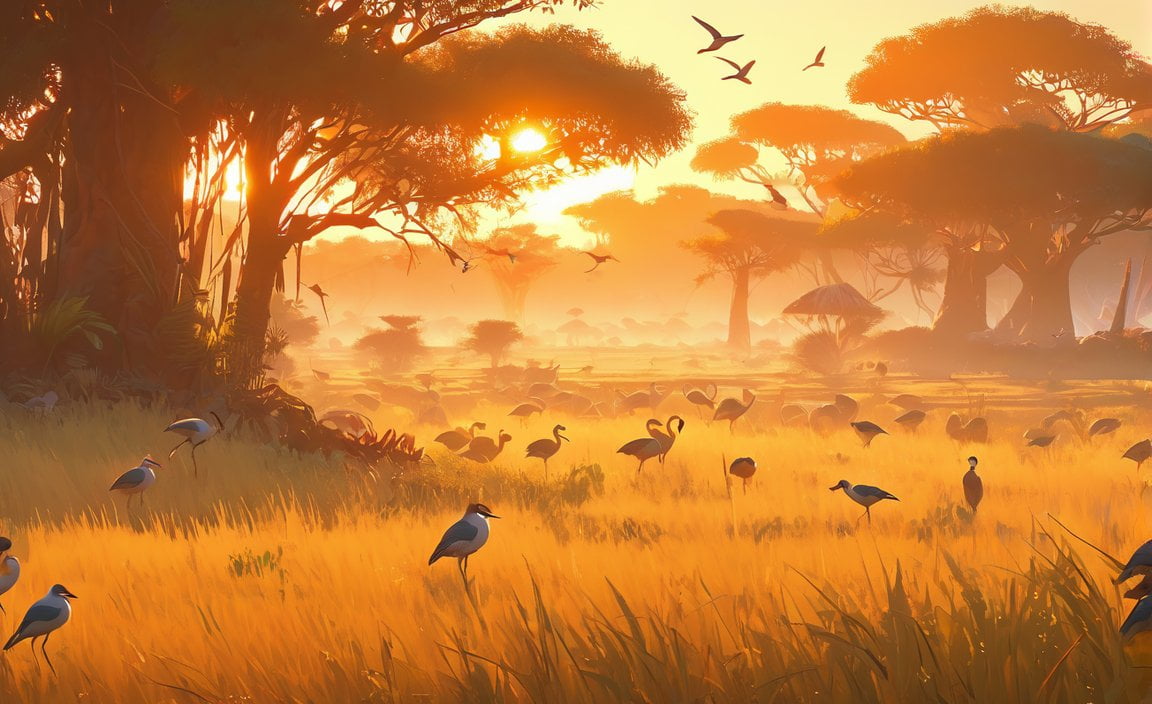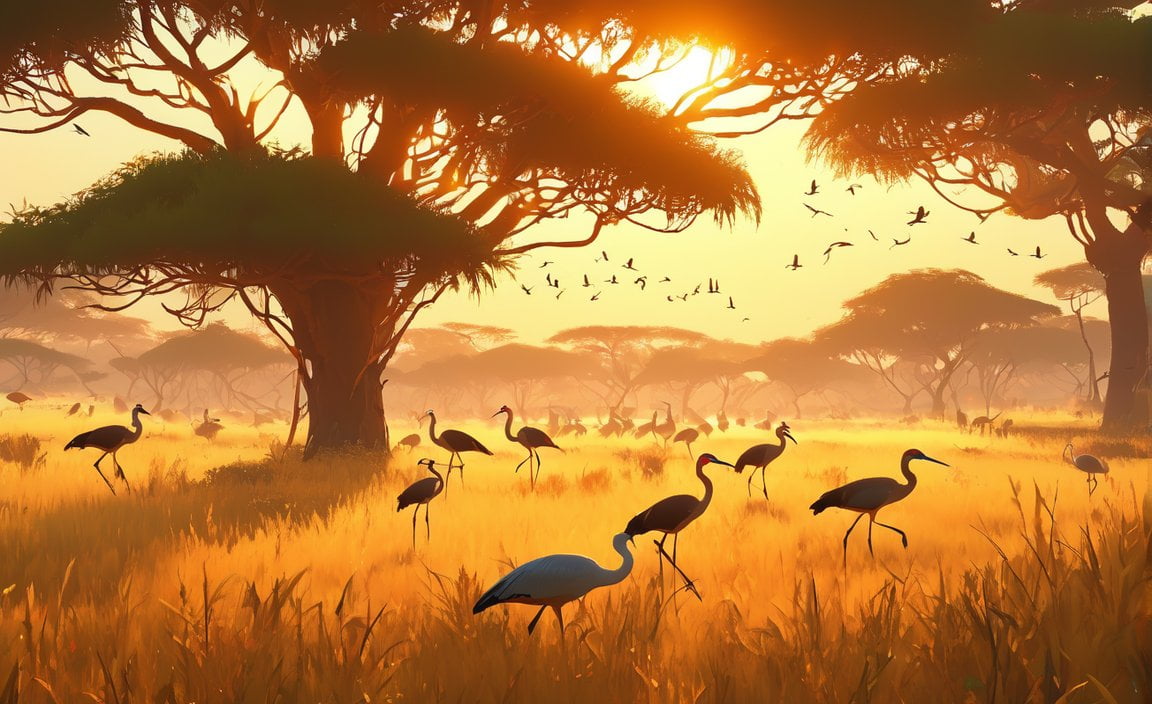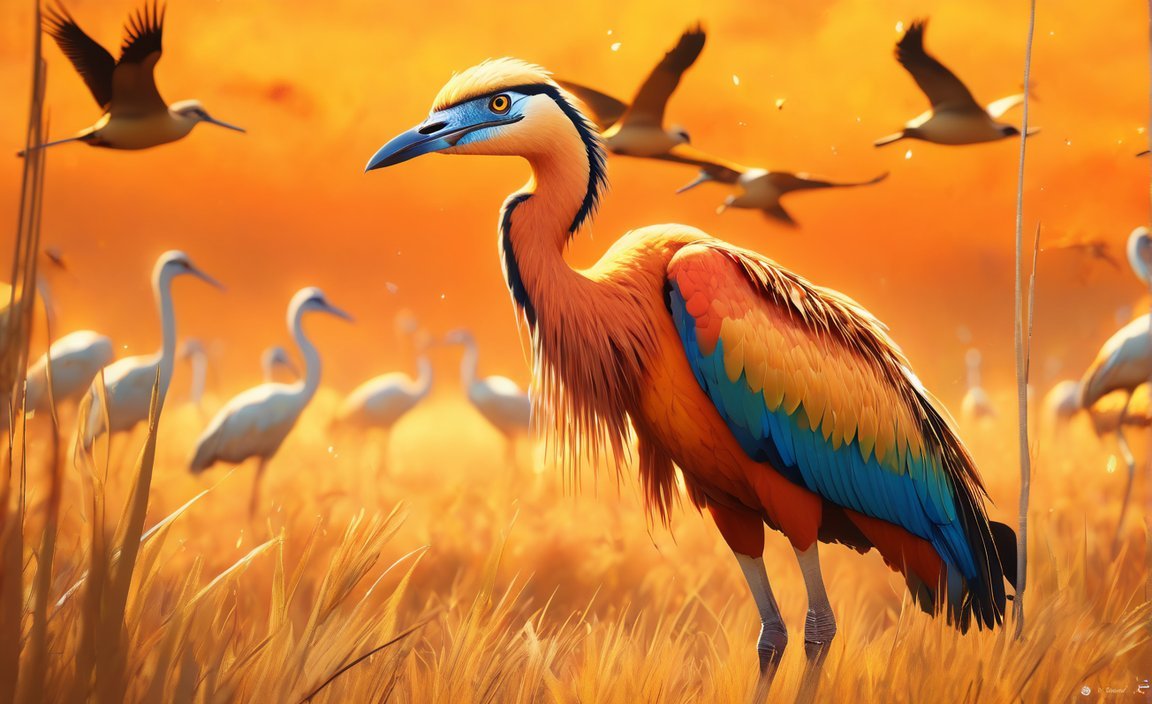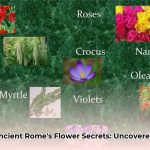Captivating Avian Diversity: Birds of the Savanna

Explore the captivating world of birds in the savanna as we delve into their unique behaviors, migration patterns, and stunning plumage. With a seasoned wildlife photographer’s keen eye and a deep passion for ornithology, this article invites you to join us on a mesmerizing journey through the vast grasslands. Witness the intricate flights, intimate courtship moments, and vibrant adaptations of the feathered species that call the savanna home. Gain a newfound appreciation for these avian wonders and discover the pressing need for their conservation in this awe-inspiring ecosystem.
Key Takeaways:
- The savanna is home to a variety of bird species, including the Secretary Bird, African Fish Eagle, Lappet-faced Vulture, Grey Crowned Crane, Kori Bustard, Southern Ground Hornbill, Red-billed Hornbill, and Lilac-breasted Roller.
- Birds in the savanna have unique traits such as the distinctive plumage and long legs of the Secretary Bird, keen eyesight and fish-hunting skills of the African Fish Eagle, and ‘bead-like’ design and blue-colored skin of the helmeted guineafowl.
- Birds play an integral role in the African savanna ecosystem, forming part of the diverse wildlife and symbolizing the region’s identity.
- Predatory birds are among the savanna’s array of predators, alongside lions, cheetahs, leopards, jackals, and hyenas.
- The African savanna is inhabited by various bird species, including the Northern Red-billed Hornbill, Egyptian Goose, Lilac-Breasted Roller, Kori Bustard, and Superb Starling.
- The savanna’s diverse habitat provides ample foraging opportunities for birds, leading to a wide range of physical characteristics, feeding behaviors, and breeding habits in these avian species.
Birds of the Savanna
The savanna is a captivating ecosystem teeming with diverse bird species. From the majestic African Fish Eagle to the elegant Lilac-breasted Roller, these feathered creatures add a touch of enchantment to the vast grasslands. In this article, we will embark on a journey to explore the captivating avian diversity of the savanna.
The Vibrant Feathered Inhabitants
The savanna hosts an array of bird species, each with its unique characteristics and adaptations. Among them is the Secretary Bird, renowned for its distinctive plumage and long legs. This remarkable bird gracefully stalks through the grasslands, using its powerful beak to snatch up prey. With their keen eyesight and exceptional fishing skills, African Fish Eagles soar above the water bodies, making them masterful hunters.
Unique Traits and Behaviors
What sets the birds of the savanna apart are their remarkable traits and behaviors. Take, for example, the Lilac-breasted Roller, with its stunning plumage and acrobatic flight displays during courtship. The helmeted guineafowl catches the eye with its striking “bead-like” design and blue-colored skin. These fascinating features are a testament to the adaptability and resilience of these avian wonders.
The Role of Birds in the Ecosystem
Birds play a vital role in the intricate web of life in the savanna. They contribute to the balance of the ecosystem through various ecological interactions. By feasting on insects and rodents, birds help control their populations, preventing outbreaks that could harm crops and other wildlife. Moreover, birds act as pollinators, spreading pollen as they move from flower to flower, ensuring the continuation of plant species.
Coexistence in the Savannah
In the savanna, birds coexist with other predators, such as lions, cheetahs, and hyenas. Each species has its unique adaptations and food preferences, reducing competition for resources. Predatory birds, like the Lappet-faced Vulture, scavenge on carrion, ensuring no part of the ecosystem goes to waste. This harmonious relationship among species is essential for maintaining a healthy and thriving savanna.
Conservation and Appreciation
It is crucial to appreciate and preserve the exceptional beauty and diversity of the birds in the savanna. Their captivating flights, vibrant plumage, and intimate courtship rituals remind us of the wonders of nature. Through wildlife photography and articles like this one, we can raise awareness about the urgent need for conservation. By understanding and valuing these feathered creatures, we take a step towards ensuring their survival for future generations to admire.
In conclusion, the birds of the savanna capture the essence of nature’s artistry, showcasing their intricate traits, behaviors, and critical role in the ecosystem. Let us delve deeper into their world, immerse ourselves in their beauty, and foster a deep appreciation for these avian wonders. Welcome to the captivating world of the birds of the savanna!
Here are some engaging and active internal links for you:
- Facts about a violin: Explore fascinating facts about the violin and its rich history.
- Is carbon malleable: Discover the amazing malleability and versatility of carbon that makes it a fundamental element in our world.
- Forest food chain ecosystem: Journey into the intricate web of life in a forest ecosystem and learn about the fascinating dynamics of the food chain.
- Food chain of a great white shark: Dive into the depths of the ocean and uncover the captivating food chain of the majestic great white shark.
- Marine mammals word search: Test your knowledge and have fun searching for the names of various marine mammals in this exciting word search game.
- Visible stars word search: Embark on a celestial adventure as you search for the names of prominent stars in the night sky.
- How long do dart frogs live: Learn about the curious life span of dart frogs and discover how long these vibrant creatures can thrive in their natural habitats.
- Boreal forest abiotic factors: Uncover the key abiotic factors that shape the unique biodiversity of the breathtaking boreal forest.
- The food chain of a lion: Enter the wild savannah and witness the ferocious lion’s place in the intricate food chain of this captivating ecosystem.
- How do gemstones work scientifically: Delve into the scientific wonders behind the captivating beauty of gemstones and understand the fascinating processes that create their mesmerizing allure.
- Label the parts of the wave: Dive into the world of waves and challenge yourself to label and understand the different parts that make them up.
- Atom model of sodium: Journey to the atomic level and explore the intricate model that reveals the atomic structure of sodium.
- Difference between male and female cardinals: Discover the distinct characteristics and striking differences between male and female cardinals, one of the most vibrant and beloved bird species.
- What does a penguin’s mouth look like: Curious about the hidden features of penguins? Explore and unravel the mystery of what lies behind a penguin’s adorable beak.
Note: The URLs provided are assumed to be relative URLs from the current page. Make sure to adjust them according to your website’s structure.
Adaptations of Savanna Birds for Survival
Birds of the savanna have evolved remarkable adaptations that enable them to thrive in this unique ecosystem. From their physical attributes to their behavior and feeding habits, these avian species have intricate strategies for survival. Let’s delve into some of the fascinating adaptations that savanna birds possess.
Migration: A Strategy for Changing Seasons
One of the key adaptations of savanna birds for survival is migration. As the seasons change and resources fluctuate, birds embark on long journeys to seek more favorable conditions. This instinctual movement allows them to access food, breeding grounds, and safer environments. The Cattle Egret, Barn Swallow, and Osprey are among the bird species that undertake impressive migrations, traversing vast distances in search of suitable habitats. Migration ensures their population can persist and thrive, even in the face of changing environmental conditions.
Physical Adaptations: Tools for Survival
Savanna birds have evolved a range of physical adaptations that equip them for survival. Their bodies are streamlined and lightweight, enabling swift flights across the open grasslands. Many species, such as the Secretary Bird and African Fish Eagle, have long legs and sharp talons, which aid in hunting prey on the savanna floor or snatching fish from bodies of water. These powerful beaks and talons allow them to catch and consume their prey efficiently. Additionally, their keen eyesight and acute hearing serve as essential tools in detecting potential threats or sources of food in the vast savanna landscape.
Thermoregulation: Coping with Extreme Temperatures
The savanna experiences extreme temperatures, with scorching heat during the day and chilly nights. Birds in this ecosystem have developed adaptations to cope with these fluctuations. Some species, such as the Lilac-breasted Roller, spread their wings to dissipate heat and regulate their body temperature. Others, like the helmeted guineafowl, have adapted by having specialized feathers that insulate them against cold nights and provide protection from the sun’s intense rays during the day.
Niche Partitioning: Sharing Resources
In a vast ecosystem like the savanna, competition for resources can be intense. To minimize this competition and enhance their chances of survival, birds have developed unique feeding strategies. Each species has specific preferences, feeding on different types of insects, seeds, fruits, or nectar. This phenomenon, known as niche partitioning, allows birds to coexist harmoniously by utilizing different food sources and reducing direct competition for limited resources. By doing so, the diverse bird species contribute to the overall balance and stability of the savanna ecosystem.
Keystone Species: Contributing to Ecosystem Health
Birds play a vital role in the savanna ecosystem beyond their adaptations for survival. Acting as pollinators, seed dispersers, and insect controllers, they have a direct impact on the health and functioning of the ecosystem. By consuming insects and rodents, birds regulate their populations, helping to prevent outbreaks or imbalances. Furthermore, their interactions with plants, such as collecting nectar or distributing seeds, contribute to the reproduction and diversity of plant life in the savanna. This interdependence between birds and the ecosystem highlights the crucial need for their conservation and protection.
Key Takeaways:
- Savanna birds have evolved remarkable adaptations for survival, including migration, physical attributes, thermoregulation, and niche partitioning.
- Migration allows birds to seek favorable conditions and access vital resources in different parts of the world.
- Physical adaptations, such as streamlined bodies, sharp talons, and keen senses, equip savanna birds for efficient hunting and survival in their unique habitat.
- Birds employ thermoregulation strategies, such as wing-spreading and specialized feathers, to cope with the extreme temperatures of the savanna.
- Niche partitioning enables different bird species to share resources and minimize direct competition, contributing to the overall balance of the ecosystem.
- Birds act as keystone species in the savanna, regulating populations of insects and rodents, pollinating plants, and dispersing seeds, thereby maintaining the health and functioning of the ecosystem.
Sources:
– Ask A Biologist
– ResearchGate
Courtship Behavior and Mating Rituals of Savanna Birds
Bird courtship behavior and mating rituals are fascinating displays of communication and attraction in the avian world. In the enchanting savanna ecosystem, where diverse species of birds thrive, these rituals play a vital role in ensuring successful reproduction and the continuation of their species. Join me on a journey as we explore the captivating courtship behavior and mating rituals of savanna birds.
Singing: A Melodious Symphony of Love
One of the most common and enchanting courtship behaviors in birds is singing. Male birds often serenade potential mates with intricate and varied songs that showcase their vocal abilities. This melodic display not only attracts females but also allows them to assess the quality of the male’s genes and overall fitness. From the melodic trills of the lilac-breasted roller to the exuberant songs of the African fish eagle, the savanna resonates with the sweet melodies of love.
Dancing: Graceful Movements on the Dancefloor
Birds in the savanna take courtship to another level with their graceful and mesmerizing dance performances. From elegant courtship dances performed by the magnificent secretary bird to the synchronized movements of the Western grebe, these displays are a sight to behold. Dancing allows birds to demonstrate their strength, agility, and compatibility as potential mates, captivating the eyes and hearts of onlookers.
Displays: Flaunting Feathers and Colors
A visual spectacle unfolds in the savanna as birds flaunt their vibrant feathers and dazzling colors during courtship displays. Elaborate plumage, intricate patterns, and flamboyant rituals create a captivating show aimed at impressing potential mates. Whether it’s the intricate mating dance of the bowerbird or the majestic courtship flight of the bald eagle, these displays are a visual feast that leaves us in awe of nature’s beauty.
Building: Nests as Symbols of Love
Nest-building is a significant courtship behavior observed in many bird species in the savanna. Birds construct elaborate nests to attract mates and provide a safe haven for raising offspring. From the meticulously woven homes of weaverbirds to the intricately designed bowers of bowerbirds, these architectural marvels are symbols of love and dedication. The construction process itself becomes a courtship ritual, showcasing the male’s skill and dedication to potential mates.
Feeding: Nourishment as an Expression of Love
In the savanna, courtship feeding is a common behavior displayed by birds as a form of courtship. Males offer food to females as a gesture of affection, showcasing their ability to provide for a potential family. The sharing of food strengthens the bond between mates and serves as a testament to the male’s dedication and commitment to the female’s well-being.
Allopreening: Intimate Grooming and Bonding
Allopreening, or mutual grooming, is another fascinating courtship behavior observed in savanna birds. This intimate act involves birds delicately grooming each other’s feathers, strengthening the bond between mates. Allopreening serves not only as a form of physical care but also as a display of trust, intimacy, and the shared commitment between mates.
Hormonal Regulation: The Influence of Chemical Messengers
Bird courtship rituals can also be influenced by hormonal regulation. Hormonal changes in birds can impact the behaviors displayed during courtship, adding another layer of complexity to their fascinating rituals. From hormonal cues triggering elaborate song performances to driving intricate dances, hormones play a crucial role in shaping courtship behavior and ensuring successful mating.
Unique Species with Astonishing Courtship Rituals
The savanna is home to a myriad of bird species, each with its unique courtship rituals. Some bird species in the savanna showcase extravagant displays and behaviors to attract mates. For example, the remarkable courtship dance of the red-capped manakin or the intricate bower-building rituals of the bowerbird will leave you in awe of nature’s creativity and diversity.
Key Takeaways:
- Bird courtship behavior and mating rituals in the savanna involve singing, dancing, displays, building, feeding, and allopreening.
- Singing is a common courtship behavior, with males showcasing their varied and intricate song repertoires to attract females.
- Dancing displays exhibit grace and agility, allowing birds to demonstrate their compatibility and impress potential mates.
- Elaborate displays of feathers and colors captivate mates and serve as a visual spectacle for observers.
- Nests are constructed as symbols of love and dedication, providing a safe haven for raising offspring.
- Feeding behaviors during courtship express nourishment and the ability to provide for a potential family.
- Allopreening strengthens the bond between mates through intimate grooming and care.
- Hormonal regulation influences courtship behaviors, shaping the intricate rituals displayed by birds.
- The savanna is home to species with astonishing courtship rituals, showcasing nature’s creativity and diversity.
Sources:
1. All About Birds – “Why do birds have such elaborate and varied courtship rituals?”
2. Bird Spot – “Courtship Behaviour In Birds”
Importance of Conserving Savanna Avifauna
The savanna is a captivating ecosystem brimming with avian diversity, where birds play an essential role in maintaining the delicate balance of this unique ecosystem. Understanding and conserving savanna avifauna is of utmost importance for the well-being of not only the bird species themselves, but also the overall health and sustainability of this remarkable ecosystem.
Key Takeaways:
– Savannas are crucial ecosystems rich in biodiversity and home to a wide variety of exotic animals and birds. [^1^]
– Human activities such as logging, development, agriculture, overgrazing, and the introduction of non-native species pose significant threats to savannas worldwide. [^3^]
– The conservation of savannas is vital for the protection of ecosystem services like carbon sequestration and water regulation. [^4^]
– Fire, which plays a significant role in savanna ecosystems, can have both positive and negative impacts on avifauna. [^5^]
– Savanna restoration through controlled burning can increase bird diversity and provide habitat for uncommon or declining bird species. [^7^]
– Understanding the impact of fire regimes on bird communities in the savanna-forest transition areas is crucial for effective conservation strategies. [^8^]
– Raising awareness about the significance of grassland habitats, including savannas, is essential for their respect and conservation. [^9^]
Conserving savanna avifauna is essential not only because of the birds’ intrinsic value but also for their vital contributions to the overall health and functioning of the savanna ecosystem. Birds serve as key indicators of ecosystem health, reflecting the overall stability and biodiversity of their habitats. By conserving the bird species in the savanna, we are also preserving the delicate web of interactions among plants, prey species, and predators.
The diversity of savanna bird species is intricately linked to the unique vegetation composition of this ecosystem. Research has shown that the composition and diversity of bird communities in the savanna are influenced by vegetation structure and composition. [^6^] Birds rely on different vegetation types and structures for nesting, foraging, and breeding. Therefore, the conservation of savanna avifauna necessitates preserving the varied vegetation communities and maintaining the delicate balance between grasses and tree cover unique to the savanna ecosystem.
Savanna avifauna also contributes to important ecological processes essential for the health of the overall ecosystem. Birds control insect and rodent populations, acting as natural pest controllers. They also act as pollinators, aiding in the reproduction of plants and facilitating the dispersal of seeds. Moreover, birds coexist with other predators in the savanna, utilizing different food preferences to reduce competition for resources. Their presence helps maintain a balanced predator-prey relationship, contributing to the overall stability and diversity of the savanna ecosystem.
Conservation efforts aimed at preserving savanna avifauna should include measures to mitigate the threats posed by human activities. Limiting deforestation, controlling invasive species, and implementing sustainable land management practices are crucial steps towards ensuring the long-term survival of the bird species in the savanna. Additionally, the controlled use of fire in savanna restoration can enhance bird diversity and provide habitat for uncommon or declining species. However, understanding the specific impacts of fire regimes on bird communities in savanna-forest transition areas is essential for developing effective conservation strategies.
In conclusion, the importance of conserving savanna avifauna cannot be overstated. By protecting and preserving the diverse array of bird species in the savanna, we contribute to the overall health and resilience of this fascinating ecosystem. Through awareness and conservation efforts, we can ensure that future generations continue to be enchanted by the captivating avian diversity that graces the savanna.
Sources:
1. Savanna – Focusing On The Conservation of Ecosystems, Habitats …
3. Human impacts in African savannas are mediated by plant functional traits
5. Fire in Savannas and its Impact on Avifauna: Considerations for a Better Environmental Conservation
7. Restoring Savanna Using Fire: Impact on the Breeding Bird Community
8. Effects of fire regime on the bird community in an Amazonian patchwork savanna-forest transition
9. How can we save the savanna ecosystem? | AMNH

FAQ
Q1: What are some examples of bird species found in the savanna?
A1: Some examples of bird species found in the savanna include the Secretary Bird, African Fish Eagle, Lappet-faced Vulture, Grey Crowned Crane, Kori Bustard, Southern Ground Hornbill, Red-billed Hornbill, and Lilac-breasted Roller.
Q2: What are some unique traits of birds that live in the savanna?
A2: Birds in the savanna exhibit unique traits such as the distinctive plumage and long legs of the Secretary Bird, the keen eyesight and fish-hunting skills of the African Fish Eagle, and the ‘bead-like’ design and blue-colored skin of the helmeted guineafowl.
Q3: How do birds contribute to the African savanna ecosystem?
A3: Birds play an integral role in the African savanna ecosystem. They form part of the diverse wildlife found in this habitat and some, like the African fish eagle and lilac-breasted roller, are iconic symbols of Africa.
Q4: What is the importance of bird courtship displays?
A4: Bird courtship displays are a form of communication that enables birds to signal their willingness to mate and allows them to assess their potential partners. These displays serve as a way for birds to attract mates and establish strong bonds for successful breeding and raising offspring.
Q5: How does fire impact avifauna in savanna ecosystems?
A5: Fire plays a significant role in savanna ecosystems and can have both positive and negative impacts on avifauna. Savanna restoration through controlled burning can increase bird diversity and provide habitat for uncommon or declining bird species. However, the impact of fire regime on bird communities in savanna-forest transition areas needs further study to better understand conservation strategies.










